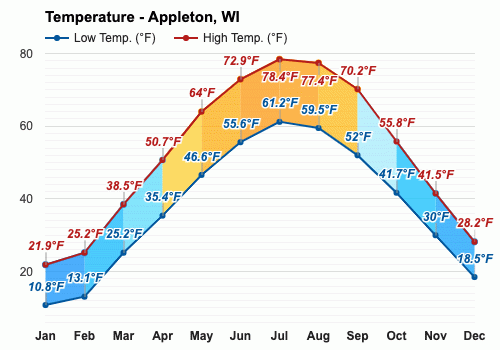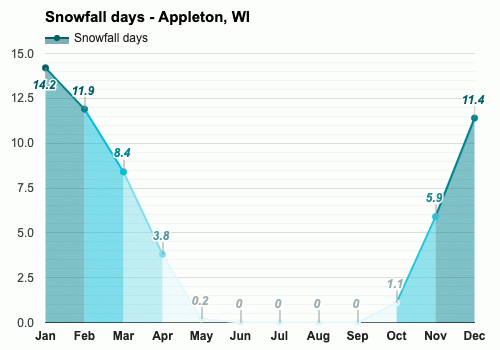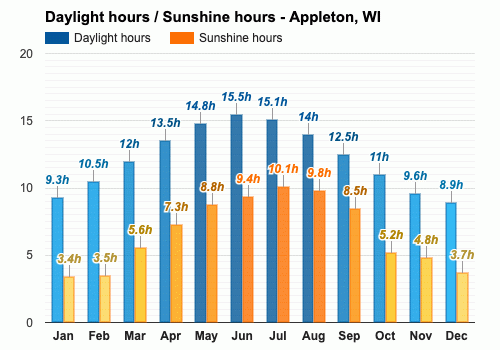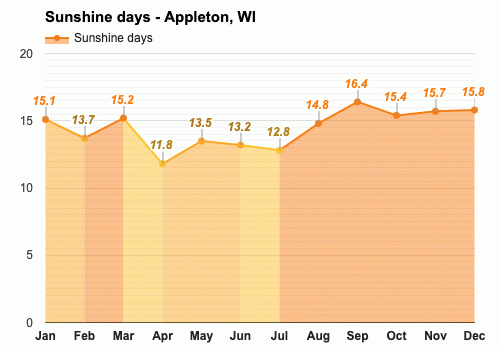Contents
- The climate of Appleton
- The best time to visit Appleton
- The worst time to visit Appleton
- Spring weather in Appleton
- Summer weather in Appleton
- Autumn weather in Appleton
- Winter weather in Appleton
- Weather in January
- Weather in February
- Weather in March
- Weather in April
- Weather in May
- Weather in June
- Weather in July
- Weather in August
- Weather in September
- Weather in October
- Weather in November
- Weather in December
- Frequently asked questions
- Average temperature
- Average pressure
- Average wind speed
- Average humidity
- Average rainfall
- Average rainfall days
- Average snowfall
- Average snowfall days
- Average daylight
- Average sunshine
- Average sunshine days
- Average UV index
- Average cloud cover
- Average visibility

Climate and monthly weather forecast
The climate of Appleton
Averaged climatological parameters reveal a clear fluctuation throughout the year. The peak temperature can roll up to 78.4°F (25.8°C) in July, while the lowest point dips to 10.8°F (-11.8°C) in January. Humidity is relatively constant throughout the year, wavering slightly between 75% in April to 88% in January and February.
Rainfall and snowfall are common phenomena, and their occurrence changes with the seasons. The number of rainy days varies between 3.9 days in January to a peak of 15.9 days in May. Snow persists from November to April with the thickest blanket, about 5.79" (147mm), seen in January. Apart from these seasons, significant snowfall is negligible.
The amount of daylight increases from 9.3 hours in January to a high of 15.5 hours in June before it starts its decline. Consequently, sunshine hours stand at a paltry 3.4 hours in January but climb to a commendable 10.1 hours by July.
Wind speed in Appleton registers minimum in July at 7.1mph (11.4km/h) and spirals up to a peak of 9.9mph (15.9km/h) in April.
The best time to visit Appleton
The worst time to visit Appleton
Spring weather in Appleton
Summer weather in Appleton
Autumn weather in Appleton
Winter weather in Appleton
Weather in January
Weather in February
Weather in March
Weather in April
Weather in May
Weather in June
Weather in July
Weather in August
Weather in September
Weather in October
Weather in November
Weather in December
Published by: Weather U.S. | About Us
Data Sources | Weather Forecasting & Climate
Frequently asked questions
What time of the year is the coldest in Appleton?
What are the most humid months in Appleton?
How much does it rain in Appleton?
When does it snow in Appleton?
When does it snow the most in Appleton?
How much does it snow in Appleton?
What is the month with the least sunshine in Appleton?
What is the month with the lowest UV index in Appleton?
What is the driest month in Appleton?
When is Daylight Saving Time (DST) in Appleton?
What is the least humid month in Appleton?
What is the wettest month in Appleton?
What are the months with the highest UV index in Appleton?
When it does not snow in Appleton?
When are the longest days in Appleton?
What time of the year is the hottest in Appleton?
What month has the most sunshine in Appleton?
What is the month with the shortest days in Appleton?

Average temperature
Appleton, WI
The warmest month (with the highest average high temperature) is July (78.4°F).
The month with the lowest average high temperature is January (21.9°F).
The month with the highest average low temperature is July (61.2°F).
The coldest month (with the lowest average low temperature) is January (10.8°F).

Average pressure
Appleton, WI
- Average pressure in January:
30.09"Hg - Average pressure in February:
30.09"Hg - Average pressure in March:
30.09"Hg - Average pressure in April:
29.96"Hg - Average pressure in May:
29.96"Hg - Average pressure in June:
29.91"Hg
- Average pressure in July:
29.95"Hg - Average pressure in August:
29.96"Hg - Average pressure in September:
30.02"Hg - Average pressure in October:
29.98"Hg - Average pressure in November:
30.06"Hg - Average pressure in December:
30.08"Hg
The months with the highest atmospheric pressure are January, February and March (30.09"Hg).
The month with the lowest atmospheric pressure is June (29.91"Hg).

Average wind speed
Appleton, WI
- Average wind speed in January:
9.8mph - Average wind speed in February:
9.8mph - Average wind speed in March:
9.4mph - Average wind speed in April:
9.9mph - Average wind speed in May:
8.8mph - Average wind speed in June:
7.8mph
- Average wind speed in July:
7.1mph - Average wind speed in August:
7.1mph - Average wind speed in September:
7.9mph - Average wind speed in October:
9.5mph - Average wind speed in November:
9.8mph - Average wind speed in December:
9.6mph
The windiest month (with the highest average wind speed) is April (9.9mph).
The calmest months (with the lowest average wind speed) are July and August (7.1mph).

Average humidity
Appleton, WI
The months with the highest relative humidity are January and February (88%).
The month with the lowest relative humidity is April (75%).

Average rainfall
Appleton, WI
- Average rainfall in January:
1.14" - Average rainfall in February:
1.06" - Average rainfall in March:
1.69" - Average rainfall in April:
2.6" - Average rainfall in May:
3.54" - Average rainfall in June:
2.68"
The wettest month (with the highest rainfall) is May (3.54").
The driest month (with the least rainfall) is February (1.06").

Average rainfall days
Appleton, WI
- Average rainfall days in January:
3.9 days - Average rainfall days in February:
4 days - Average rainfall days in March:
10.3 days - Average rainfall days in April:
14.6 days - Average rainfall days in May:
15.9 days - Average rainfall days in June:
14.8 days
- Average rainfall days in July:
15.1 days - Average rainfall days in August:
12.8 days - Average rainfall days in September:
12.1 days - Average rainfall days in October:
12.2 days - Average rainfall days in November:
9.2 days - Average rainfall days in December:
6.2 days
The month with the highest number of rainy days is May (15.9 days).
The month with the least rainy days is January (3.9 days).

Average snowfall
Appleton, WI
- Average snowfall in January:
5.79" - Average snowfall in February:
4.8" - Average snowfall in March:
2.32" - Average snowfall in April:
2.76" - Average snowfall in May:
0.08" - Average snowfall in June:
0"
The month with the highest snowfall is January (5.79").
The months with the least snowfall are June, July, August and September (0").

Average snowfall days
Appleton, WI
- Average snowfall days in January:
14.2 days - Average snowfall days in February:
11.9 days - Average snowfall days in March:
8.4 days - Average snowfall days in April:
3.8 days - Average snowfall days in May:
0.2 days - Average snowfall days in June:
0 days
- Average snowfall days in July:
0 days - Average snowfall days in August:
0 days - Average snowfall days in September:
0 days - Average snowfall days in October:
1.1 days - Average snowfall days in November:
5.9 days - Average snowfall days in December:
11.4 days
The month with the highest number of snowfall days is January (14.2 days).
The months with the least snowfall days are June, July, August and September (0 days).

Average daylight / Average sunshine
Appleton, WI
- Average daylight in January:
9h and 2min - Average daylight in February:
10h and 3min - Average daylight in March:
12h and 0min - Average daylight in April:
13h and 3min - Average daylight in May:
14h and 5min - Average daylight in June:
15h and 3min
- Average daylight in July:
15h and 1min - Average daylight in August:
14h and 0min - Average daylight in September:
12h and 3min - Average daylight in October:
11h and 0min - Average daylight in November:
9h and 4min - Average daylight in December:
8h and 5min
The month with the longest days is June (Average daylight: 15h and 30min).
The month with the shortest days is December (Average daylight: 8h and 54min).
- Average sunshine in January:
3h and 2min - Average sunshine in February:
3h and 3min - Average sunshine in March:
5h and 4min - Average sunshine in April:
7h and 2min - Average sunshine in May:
8h and 5min - Average sunshine in June:
9h and 2min
- Average sunshine in July:
10h and 1min - Average sunshine in August:
9h and 5min - Average sunshine in September:
8h and 3min - Average sunshine in October:
5h and 1min - Average sunshine in November:
4h and 5min - Average sunshine in December:
3h and 4min
The month with the most sunshine is July (Average sunshine: 10h and 6min).
The month with the least sunshine is January (Average sunshine: 3h and 24min).

Average sunshine days
Appleton, WI
- Average sunshine days in January:
15.1 days - Average sunshine days in February:
13.7 days - Average sunshine days in March:
15.2 days - Average sunshine days in April:
11.8 days - Average sunshine days in May:
13.5 days - Average sunshine days in June:
13.2 days
- Average sunshine days in July:
12.8 days - Average sunshine days in August:
14.8 days - Average sunshine days in September:
16.4 days - Average sunshine days in October:
15.4 days - Average sunshine days in November:
15.7 days - Average sunshine days in December:
15.8 days
The month with the most sunshine days is September (16.4 days).
The month with the least sunshine days is April (11.8 days).

Average UV index
Appleton, WI
The months with the highest UV index are May, June, July and August (UV index 5).
The months with the lowest UV index are January, November and December (UV index 1).

Average cloud cover
Appleton, WI
The month with the most cloud cover is January (Cloud cover 63).
The month with the least cloud cover is July (Cloud cover 32).

Average visibility
Appleton, WI
The months with the highest visibility are March, April, May, June, July, August, September, October and November (6mi).
The months with the lowest visibility are January, February and December (5mi).